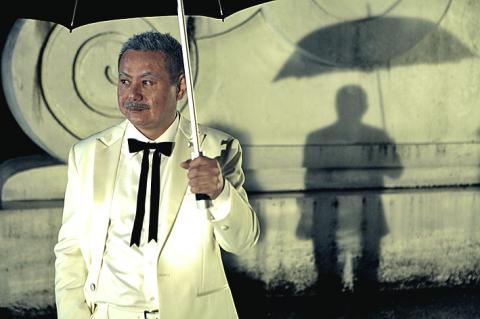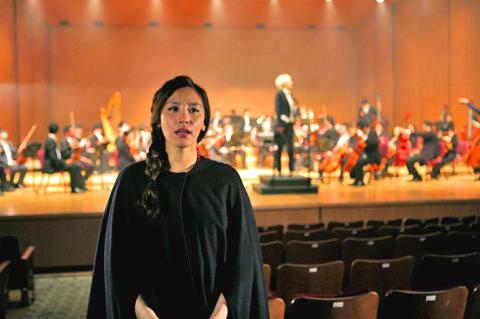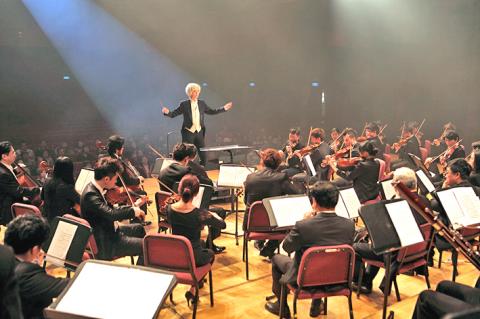In 2010, a group of Puyuma Aboriginal musicians from Taitung’s Nanwang Tribe (南王部落) performed On the Road (很久沒有敬我了你) at Taipei’s National Concert Hall (國家音樂廳). Unusual for a musical performed at Taiwan’s top venue for classical music, it blended tribal sounds and dance with contemporary music and a Western orchestra.
But the ambitious project, a collaboration among record label Taiwan Colors Music (TCM, 角頭音樂), the National Symphony Orchestra (NSO, 國家交響樂團) and National Theater & Concert Hall (NTCH, 國家兩廳院), didn’t end when the curtain dropped. Kara-Orchestra (很久沒有敬我了妳), a cinematic complement to the musical, opens in theaters nationwide today.
Directed by Wu Mi-sen (吳米森) and produced by TCM President Zhang 43 (張四 十 三), the film examines topics — why and how Aboriginal music is altered or made palatable for a more sophisticated audience, what it means to be Taiwanese — that its theatrical counterpart only hinted at.

Photo courtesy of Activator Marketing Company
Incidentally, The Making of On The Road (很久), a 2011 documentary by Amis director Lungnan Isak Fangas, raised many of the issues addressed in Kara-Orchestra. That film featured interviews with artists and musicians who participated in the musical, including Hu, Hao-en, Pau-dull (陳建年) and music producer Cheng Chieh-jen (鄭捷任), and takes a deeper look into the question concerning indigenous music and its admission to the Han-Chinese centric system.
CONVENTIONAL STRUCTURE
Those familiar with Wu’s poetic and cinematic vocabulary, so eloquently shown in Fluffy Rhapsody (起毛球了, 2000) and Amour-Legende (松鼠自殺事件, 2006), will be surprised at the conventional three-act structure of this new offering. A young female musician, Feng Huo-yun (Youki, 侑紀), is appointed by NTCH director Chang San-lang (Tsai Chen-nan, 蔡振南) as the NSO’s new conductor. Conflicts erupt between Feng and principal violinist Tung jen-to (Leon Dai, 戴立忍) because Tung doubts the young conductor’s ability to lead the orchestra.

Photo courtesy of Activator Marketing Company
THE PRANK
During a rehearsal, an Aboriginal woman appears in the audience. She sings for a brief moment, and then disappears. It later turns out to be a joke by Tung and his friends, played by the legendary Kimbo Hu (胡德夫), Samingad (紀曉君) and Yangui Yasiungu (安歆澐), meant to show that Aboriginal music is as good as any show.
Tung’s mischievous prank, however, inspires Chang. Feng and Dai are then sent to the Aboriginal village to collaborate on a work. The two meet villagers and musicians such as Hao-en (昊恩) and the Nanwang Sisters (南王姐妹花). Feeling excluded at first, Feng gradually earns her place and reconciles with Tung.

Photo courtesy of Activator Marketing Company
Back in Taipei, Chang loses his job to a wealthy Chinese businessman, amusingly played by exiled Chinese dissident Wang Dan (王丹). It’s promptly replaced with a Chinese music production.
The makeshift group of musicians, however, are determined to retake the stage.
SOCIAL ISSUES

Photo courtesy of Activator Marketing Company
While promising, the film lacks structure and dramatic nuance. The initial antagonism and later reconciliation between the two leads are less narratively cogent. Japanese-Taiwanese actress Youki might be good for a role that metaphorically reflects Taiwan’s past and present, but there is little intensity in her portrayal of an over-achieving young woman searching for her roots.
The film succeeds when it adopts humor to tackle serious issues. The question of whether tribal music and dance should be performed in a national theater is playfully touched on in a sequence where tribal villagers, who have no understanding of musical notation, happily use a karaoke machine to practice.
The presence of many indigenous musicians showing off their singing prowess is one of the movie’s many pleasures. Cameo appearances by public figures such as architect Roan Ching-yueh (阮慶岳), writer and former Taipei mayoral candidate Neil Peng (馮光遠) and Lin Wen-yi (林文義), a well-known novelist and social critic, suggest that the film’s non-Aboriginal characters are on their own kind of inner journey while discovering the nation’s indigenous heritage.

Photo courtesy of Activator Marketing Company

Photo courtesy of Activator Marketing Company

Photo courtesy of Activator Marketing Company

Photo courtesy of Activator Marketing Company

Exceptions to the rule are sometimes revealing. For a brief few years, there was an emerging ideological split between the Democratic Progressive Party (DPP) and Chinese Nationalist Party (KMT) that appeared to be pushing the DPP in a direction that would be considered more liberal, and the KMT more conservative. In the previous column, “The KMT-DPP’s bureaucrat-led developmental state” (Dec. 11, page 12), we examined how Taiwan’s democratic system developed, and how both the two main parties largely accepted a similar consensus on how Taiwan should be run domestically and did not split along the left-right lines more familiar in

This month the government ordered a one-year block of Xiaohongshu (小紅書) or Rednote, a Chinese social media platform with more than 3 million users in Taiwan. The government pointed to widespread fraud activity on the platform, along with cybersecurity failures. Officials said that they had reached out to the company and asked it to change. However, they received no response. The pro-China parties, the Chinese Nationalist Party (KMT) and Taiwan People’s Party (TPP), immediately swung into action, denouncing the ban as an attack on free speech. This “free speech” claim was then echoed by the People’s Republic of China (PRC),

As I finally slid into the warm embrace of the hot, clifftop pool, it was a serene moment of reflection. The sound of the river reflected off the cave walls, the white of our camping lights reflected off the dark, shimmering surface of the water, and I reflected on how fortunate I was to be here. After all, the beautiful walk through narrow canyons that had brought us here had been inaccessible for five years — and will be again soon. The day had started at the Huisun Forest Area (惠蓀林場), at the end of Nantou County Route 80, north and east

Specialty sandwiches loaded with the contents of an entire charcuterie board, overflowing with sauces, creams and all manner of creative add-ons, is perhaps one of the biggest global food trends of this year. From London to New York, lines form down the block for mortadella, burrata, pistachio and more stuffed between slices of fresh sourdough, rye or focaccia. To try the trend in Taipei, Munchies Mafia is for sure the spot — could this be the best sandwich in town? Carlos from Spain and Sergio from Mexico opened this spot just seven months ago. The two met working in the